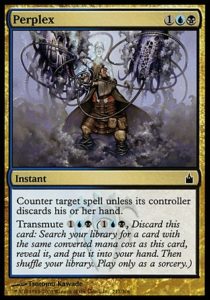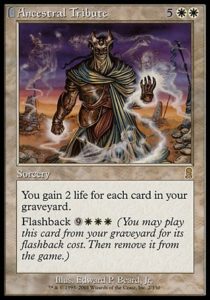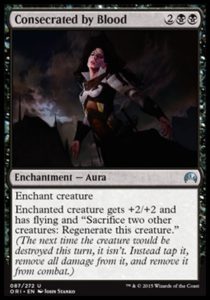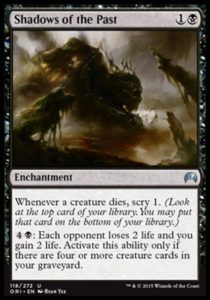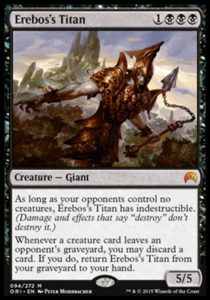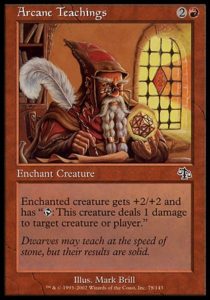Magic is a fantastic, albeit extremely complicated game. It has a very high initial learning curve—there are a ton of rules and vocabulary words to learn, not to mention the flavor, strategy, and ability to evaluate constantly changing game states. However, once we understand and internalize all of the basics (making way for the even more complicated world of competitive Magic), it becomes much harder for us to see the hurdles we’ve left behind. If you read Mark Rosewater’s Tumblr, Blogatog (which is a fantastic blog and absolutely worth reading), you’ll see this often.
Some people, particularly those who’ve been playing for a long time, are frustrated with those players who struggle with mechanics like Shroud or the complexity of sets like Time Spiral and Lorwyn. They argue that Wizards shouldn’t ‘cater’ to people who have trouble with complexity. Rosewater’s typical response is fantastic: when a large amount of players get something wrong, it’s not the players’ fault, but the designers’. Good design is intuitive; bad design is confusing.
I grant that sometimes we overlook the obvious, where it’s our fault and the not designer’s. For example, how often have you seen someone try to cast Healing Hands or Glare of Heresy as an instant? They resemble instants like Renewed Faith and Celestial Purge, so we assume they’re insants. I don’t fault these cards for bad design; they’re simple, straightforward cards that we’re not reading carefully likely because we’re experienced with the game. A bad design would be something like a sorcery speed counterspell (since it doesn’t work).
Sometimes, designs are rather complicated but make sense with a bit of practice. Think of Morph, Manifest, and Double-Faced Cards: they’re a doozy when you first play with them, but tend to be quickly understood thereafter. Such mechanics are problematic when they’re either too unintuitive (Soulbond), too cumbersome (Suspend), too numerous (Time Spiral), or create paralyzing complexity (Lorwyn).
I believe that Wizards has gotten very good at making more intuitive designs and fewer clunkers, particularly at lower rarities. However, Magic Origins seems to have a disproportionate number of confusing designs. Furthermore, the abundance of complicated cards and mechanics at lower rarities compounds the problem; you’re more likely to miss the unusual thing one card does if lots of cards are doing different unusual things.
Magic Origins has a lot of sweet callbacks to past Magic mechanics:
- Zendikar’s Roil has Landfall.
- Deep-Sea Terror has Threshold.
- Kytheon, Hero of Akros has Batallion
- Starfield of Nyx has pseudo-Devotion
- Sigil of Valor grants your creatures Exalted.
- Herald of the Pantheon, Blessed Spirits, Sigil of the Empty Throne, and Blightcaster have pseudo-Constellation.
- Patron of the Valiant has pseudo-Proliferate.
- Call of the Full Moon has half of the Werewolf mechanic.
- Somberwald Alpha has half of Bushido.
Individually, I like all of these cards. Collectively, they constitute a lot of one-of (or few-of) mechanics. Remembering all of these disparate effects takes up mental energy. I’ll generally forgive rares and mythic rares, since high rarity allows cards to do crazy things. While uncommons are also allowed a lot of complexity points, I believe that the high variety of uncommon effects in Magic Origins makes it harder to remember everything. The diversity of mechanics is generally balanced by the fact that each mechanic-homage card is simple, doing only one or two things. However, there are a couple clunkers that people seem to keep getting wrong.
Consecrated by Blood provides the initial impetus for this article. It has three separate abilities, all crammed into one paragraph, which is smushed atop regenerate’s lengthy reminder text (which is itself an ability made unintuitive by the Sixth Edition rules change, and so demands reminder text).
So… did you know that Consecrated by Blood grants flying? It’s easy to miss, given that it’s obscured by a line break, buried in eight lines of text, and not suggested by the card’s name or artwork. Vampires in Origins aren’t strongly associated with flying—of the three vampires in the set, only Rabid Bloodsucker has flying, and it’s the only one which looks inhuman (whereas the subject in this aura is clearly human-looking, nor does the aura explicitly make a creature into a vampire).
How would I change this design? There’s no room for additional rules text, rules follows a specific order, and we can’t remove the flavor text. I’d do one of two things: either remove flying (which lowers the power of the card, but is how most players seem to expect it to work) or have the artwork clearly demonstrated a creature in flight.
I’ve seen too many players inadvertently cheat by using Shadows of the Past‘s drain mode with an unfilled graveyard (they either forget the clause or counted their opponent’s graveyard, too). I don’t blame them; Shadows of the Past is another uncommon with three separate components, one of which is easily missed. It tracks four separate things: your library, the death of any player’s creature, all players’ life totals, and how many creatures are in your graveyard. It has a triggered ability and an unrelated activated ability with a mana cost. It is, to the best of my knowledge, the only card in Magic Origins with an activated ability that has a timing restriction (aside from things being limited to Sorcery-speed). It also has a never-before-been-seen threshold mechanic in a set full of one-of threshold mechanics.
I don’t think that this card is a bad design in isolation; it does a lot of things, sure, but there’s a definite connection between you learning from creature’s sins, er, deaths. I just think it’s just a bad fit for Magic Origins. Too many one-use mechanics are competing for mental space in this set for this card to be remembered properly. I’d be intrigued to see an entire set employ and perhaps keyword (well, technically ability word) this threshold mechanic.
While I said I shouldn’t criticize higher rarity cards for inelegant design, I couldn’t resist talking about these two cards.
Woodland Bellower has a strange set of restrictions for a mythic rare card that does only one thing. Green is able to tinker for any color of creature (Birthing Pod, Chord of Calling, Yisan, the Wanderer Bard, Protean Hulk), and less frequently restricts itself to only cheat in green creatures (Green Sun’s Zenith, Dramatic Entrance, Natural Order, Garruk, Caller of Beasts). Furthermore, why is Woodland Bellower not allowed to find Legendary creatures? I understand that Liliana, Defiant Necromancer can’t Zombify legendary creatures for flavor reasons (since she can’t resurrect her brother) and possibly development concerns (though she can still flip to you playing a second Liliana, Heretical Healer, which is a bizarre flavor fail), but is it so terrible for the six mana mythic to find Nissa, Vastwood Seer or Anafenza, the Foremost?
It just feels strange for a splashy card to have such a limited range of available options. I understand that cheating any creature into play would be too strong, but limited it to cheap, green, nonlegendary creatures feels like overkill (and I’ve seen these restrictions inadvertently violated by players who just assume it’s any CMC 3 or less creature). It just feels like it has a bit more (restrictive and easily forgettable) trinket text than it needs.
Erebos’s Titan, on the other hand, looks like development messed around with what once was a more intuitive and flavorful card. Perhaps it’s supposed to hose some strategy coming in the next year, but it’s nevertheless bizarre. Why does Erebos get in a tizzy when Relic of Progenitus pops? Why is his minion only protected when it’s not doing his bidding and hunting down an escaped soul? I understand that indestructible isn’t purely for creature combat, but I feel like the titan has a baffling ability akin to “As long as your opponents control no creatures with flying or reach, Thassa’s Titan has flying,” or “As long as your opponents control no creatures, Nylea’s Titan has trample, menace, and deathtouch.”
But perhaps I’m just being grumpy.
I’d like to hear what you think. Are you seeing a lot of mistakes with Origins cards? Am I dealing with far too small of a sample size and you’re not seeing any of these errors? Do you prefer a set that has more limited-use mechanics? Did you notice all of the throwback mechanics? Did I miss some? Feel free to respond in the comments below. And as always, thanks for reading.
—Zachary Barash
Zachary Barash has been playing Magic on and off since 1994. He loves Limited and drafts every available format (including several that aren’t entirely meant to be drafted). He’s a proud Cube owner, improviser, and game designer. He has an obsession with Indian food that borders on being unhealthy.

